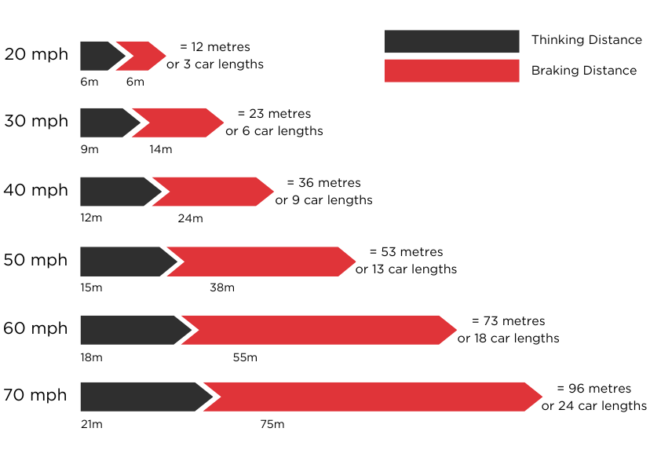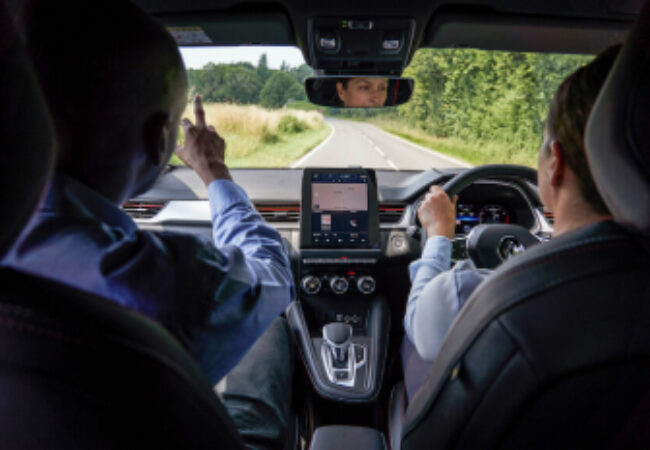

Knowing your vehicle’s stopping distance is an important part of passing your driving test, but it’s also something that can be all too quickly forgotten in our day-to-day driving. In fact, tailgating – not allowing enough stopping distance to the car in front – is one of the biggest causes of road accidents in the UK. So, whether you’re studying for your theory test or revising the rules of the road, we’re here to help.
In simple terms, stopping distance is the time that it takes to bring a moving vehicle to a complete stop. This includes the time it takes to realise the hazard, react to it and the vehicle coming to a complete stop.
Stopping distance = thinking distance + braking distance

The following stopping distances are a useful guide from the Highway Code. The data is based on an average-sized family car, stopping in normal weather conditions. As you’ll see the faster a car is travelling, the longer it takes to stop. Travelling at 40mph rather than 30mph for example, means it will take 13 more metres to stop the car – equivalent to 3 averaged sized cars, hence why adhering to speed limits is so important.
The 2-second rule is a quick and practical way of checking your stopping distance when you are travelling in your car. It is a rough guide and you should allow a greater distance when travelling at faster speeds or in bad weather conditions.
Here’s how it works:
Stopping distance is determined by more than just speed and in truth, there are many factors that influence the stopping distance of a vehicle. They can broadly be put into three categories: driver awareness, vehicle condition and environmental factors. We take a look at each in more detail below:
Stress and Emotions: Stress and pressure are a common part of our busy lives but they can have a big impact on our driving. Whether you’re running late, desperate to get home after a long day at work or experiencing a case of road rage. Feelings of stress and pressure can lead to higher speeds, shorter separation gaps and slower reaction times.
Drink and Drugs: It goes without saying that you shouldn’t drink and drive, and it is also illegal to drive under the influence of certain drugs. Why? Because consuming alcohol and drugs increases the time it takes to process information such as hazards on the roads and therefore increases your stopping distance.
Vehicle size and weight: Larger and heavier vehicles have a longer braking distance than smaller, lighter vehicles. Why? It’s all to do with physics and the fact that more force is required to stop a heavier vehicle.
Field of vision: How far and clearly a driver can see also has a significant impact on stopping distance. Fog, for example, can massively impact your field of vision, giving you less time to respond to the hazard or vehicle stopping in front of you.
Other road users: Whilst you cannot control the actions of other road users it’s important to allow for a ‘margin-of-error’ in your driving, to avoid a rear-end shunt from the vehicle behind. Allowing plenty of space in front, behind and to the left and right of your vehicle should prevent any accidents. If you feel you’re being tailgated simply pull over safely and let the vehicle pass.

It’s fair to say that here in the UK we have quite a lot of rain. But how does this impact a vehicle’s stopping distance? According to the Highway Code, a vehicle’s stopping distance in rain is doubled. It is therefore recommended that a driver leaves double the amount of space between themselves and the car in front to allow extra time to respond to the hazard. If you are familiar with using the 2-second rule, double the gap to 4 seconds when it’s wet.
Stopping distances are commonly examined in the theory test, but they’re not always easy to remember. So, the good news is that with a little bit of maths you can calculate the stopping distance yourself:
| Speed (mph) | Multiple by 0.5 intervals | Calculation | Stopping distance (feet) |
|---|---|---|---|
| 20 | 2 | 20 x 2 | 40 ft |
| 30 | 2.5 | 30 x 2.5 | 75 ft |
| 40 | 3 | 40 x 3 | 120 ft |
| 50 | 3.5 | 50 x 3.5 | 175 ft |
| 60 | 4 | 60 x 4 | 240 ft |
| 70 | 4.5 | 70 x 4.5 | 315 ft |
Whether you’re new to driving or have years of experience, knowing your stopping distances is a crucial part of staying safe on the roads. Leaving enough distance between you and the car in front lets you react and stop in time if cars ahead suddenly brake, helping to avoid any costly accidents.